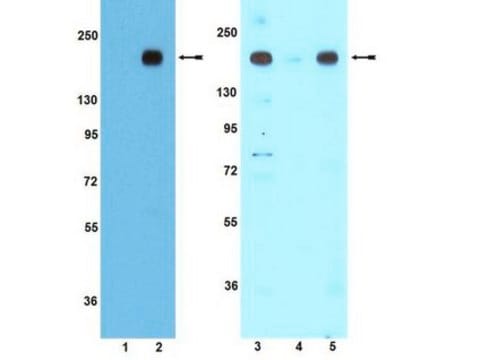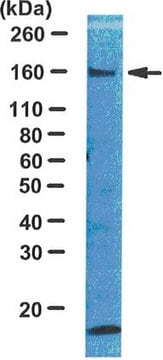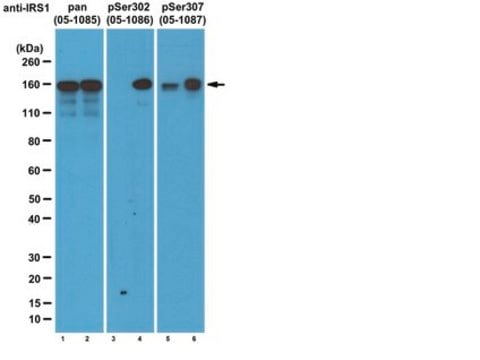05-784R
Anti-IRS1 Antibody, clone 58-10C-31, rabbit monoclonal
clone 58-10C-31, from rabbit
Sinonimo/i:
insulin receptor substrate 1
About This Item
Prodotti consigliati
Origine biologica
rabbit
Livello qualitativo
Forma dell’anticorpo
purified immunoglobulin
Tipo di anticorpo
primary antibodies
Clone
58-10C-31, monoclonal
Reattività contro le specie
human, rat, mouse
tecniche
immunoprecipitation (IP): suitable
western blot: suitable
Isotipo
IgG
N° accesso NCBI
N° accesso UniProt
Condizioni di spedizione
dry ice
modifica post-traduzionali bersaglio
unmodified
Informazioni sul gene
human ... IRS1(3667)
Descrizione generale
Specificità
Immunogeno
Applicazioni
Metabolism
Insulin/Energy Signaling
Immunoprecipitation Analysis: 1 µg from a previous lot immunoprecipitated IRS-1 from 100 µg of MCF7 cell lysate. Arrow indicates IRS-1 (~160 kDa). There is cross reactivity of the detection antibody with the heavy chaing of Rabbit IgG as shown at ~50 kDa.
Qualità
Western Blot Analysis: 0.1 µg/mL of this antibody detected IRS-1 on 10 µg of 3T3/A31, 3T3/L1, L6, or MCF7 cell lysates.
Descrizione del bersaglio
Stato fisico
Stoccaggio e stabilità
Handling Recommendations: Upon receipt and prior to removing the cap, centrifuge the vial and gently mix the solution. Aliquot into microcentrifuge tubes and store at -20°C. Avoid repeated freeze/thaw cycles, which may damage IgG and affect product performance.
Note: Variability in freezer temperatures below -20°C may cause glycerol containing solutions to become frozen during storage.
Risultati analitici
3T3/A31, 3T3/L1, L6, or MCF7 cell lysates
Altre note
Esclusione di responsabilità
Not finding the right product?
Try our Motore di ricerca dei prodotti.
Codice della classe di stoccaggio
12 - Non Combustible Liquids
Classe di pericolosità dell'acqua (WGK)
WGK 1
Punto d’infiammabilità (°F)
Not applicable
Punto d’infiammabilità (°C)
Not applicable
Certificati d'analisi (COA)
Cerca il Certificati d'analisi (COA) digitando il numero di lotto/batch corrispondente. I numeri di lotto o di batch sono stampati sull'etichetta dei prodotti dopo la parola ‘Lotto’ o ‘Batch’.
Possiedi già questo prodotto?
I documenti relativi ai prodotti acquistati recentemente sono disponibili nell’Archivio dei documenti.
Il team dei nostri ricercatori vanta grande esperienza in tutte le aree della ricerca quali Life Science, scienza dei materiali, sintesi chimica, cromatografia, discipline analitiche, ecc..
Contatta l'Assistenza Tecnica.








